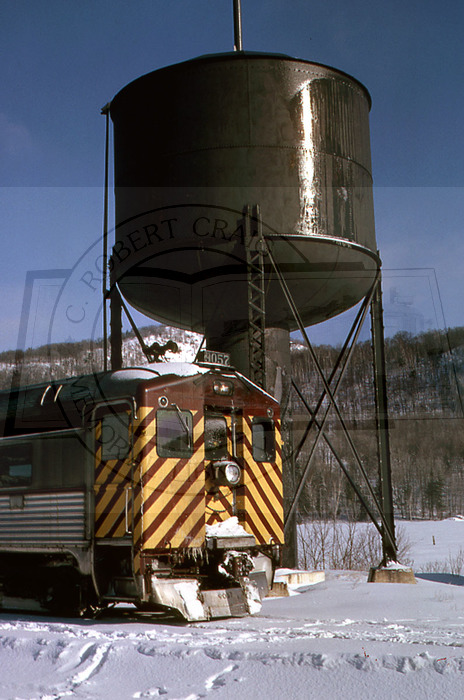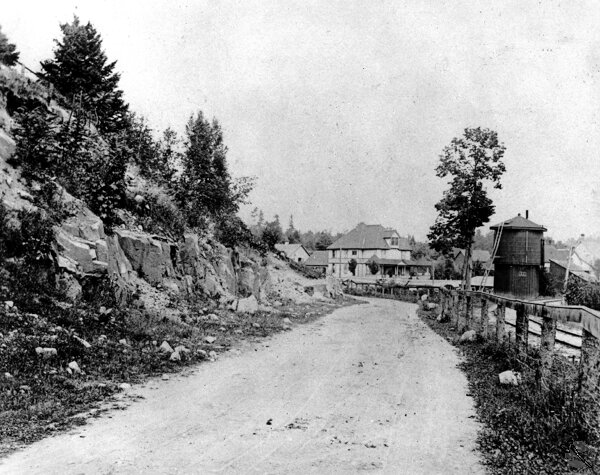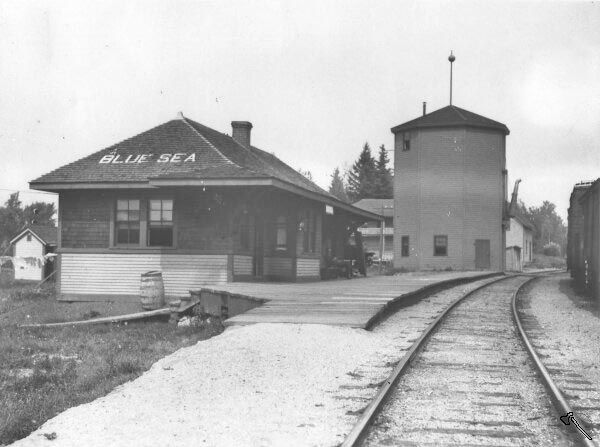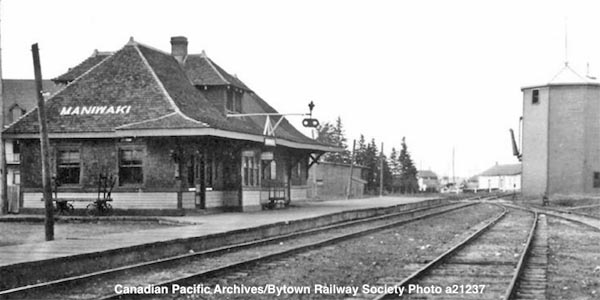Canadian Pacific Water Facilities in the Ottawa - Smiths Falls Area
These notes have been prepared by Andrew Jeanes with input from many members of the Ottawa Railway History Circle| Maniwaki subdivision | ||
| Hull, QC | No information, 10/30/60, no water at Hull (Bruce Chapman) See also Lachute sub. | |
| Tenaga, QC | Ottawa Citizen 19 August 1908 At Tenaga on the Gatineau Valley Railway, the tank for filling the boilers of engines, which has always rather marred the scenic effect of the spot is to be taken away. A dam is being built across the creek, which runs into the river, and pipes running from this dam will supply the engines in future |  Photo by J.W. Heckman, 1914, Canadian Pacific Archives/Gatineau Valley Historical Society a21227 https://www.gvhs.ca/Imagegallery/CD-026/02326-007.jpg |
| Cascades, QC |  C. Robert Craig Photo, 1963, CRCML C02_CS_00457 | 10/30/60, no water at Cascades (Bruce Chapman) |
| Wakefield, QC | Ottawa Free Press 5 December 1890 The piles for the new Gatineau Valley railway bridge at the Peche are now being driven, and the erection of the new station at Wakefield commenced. A large tank house is in process of construction at the Peche. The Equity, Shawville 2 July 1891 All stations are now built to the Peche and at the latter point the tank is finished. This tank will hold 20,000 gallons and by an ingenious contrivance of Mr. White's the exhaust steam from the cylinder is forced back into the tank and there condenses, thus saving much expense. The pumping engine and machinery are all under cover of the tank rendering the whole frost proof and saving an immense amount of fuel. |  Gatineau Valley Historical Society https://www.gvhs.ca/Imagegallery/CD-003/00287.jpg |
| Aylwin, QC | Standpipe only, described by Duncan du Fresne in “Tid Bits” Branchline Vol 29 No. 10, November 1990, p9, no photo 10/25/59 Aylwin and Blue Sea have lost their ‘W’ (Bruce Chapman) From Bill McConnell There was no tank at Aylwin. There was a standpipe for watering engines. The water was piped to it via a 10 or 12 inch wire wound wooden stave pipe from a dam on a creek a half mile west of the RR. The creek originated at Quinn's Lake. The pipe crossed under a public road in several places and was prone to leaks in those areas. Repair crews would dig down where these leaks occurred and apply metal bands to tighten the staves together. Each length of pipe was tightly wound with 1/4 to 3/8 inch thick wire like a coil spring. Each end of the wire was bent 90 degrees and placed in a drilled hole in a wooden stave to retain the pressure exerted by the wire on the staves. When a rusting fracture occurred anywhere on the wire winding, the pressure exerted by the wire that held the staves tightly together was relaxed and leakage occurred. Each pipe length had a male and female taper that allowed the pipes to be fitted together. That piping might still be visible where it crosses on the bed of a little stream that ran past on the north side of where the standpipe was located. | |
| Blue Sea, QC |  Gatineau Valley Historical Society (this is almost certainly a J.W. Heckman photo as well) https://www.gvhs.ca/Imagegallery/CD-026/02326-004.jpg | 10/25/59 Aylwin and Blue Sea have lost their ‘W’ (Bruce Chapman) |
| Maniwaki, QC |  Photo by J.W. Heckman, 1914, Canadian Pacific Archives/Bytown Railway Society a21237 | Canadian Railway and Marine World April 1926 A steel tank of 40,000 gals capacity will be built at Maniwaki 10/30/60, no water at Maniwaki (Bruce Chapman) |
Updated 3 May 2020
Home Main Findings Page CPR Water Facilities Page
